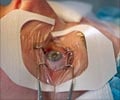Neuroscientists at the Institute of Neuroscience in Alicante, Spain claim to have solved the mystery as to why some people see Mona Lisa's smile and some don't.
Neuroscientists at the Institute of Neuroscience in Alicante, Spain claim to have solved the mystery as to why some people see Mona Lisa's smile and some don't.
According to boffins, Leonardo Da Vinci's Mona Lisa is both smiling and not smiling, depending on what cells in the retina pick up the image and what channel the image is transmitted through in the brain."Sometimes one channel wins over the other, and you see the smile, sometimes others take over and you don't see the smile," says Luis Martinez Otero, a neuroscientist at Institute of Neuroscience in Alicante, Spain, who conducted the study along with Diego Alonso Pablos.
To reach the conclusion, scientists used software to track 20 volunteers, reports New Scientist.
The research also showed that Leonardo Da Vinci intentionally tried to capture both views.
The finding was presented at the Society for Neuroscience's annual meeting in Chicago this week.
Source-ANI
SRM
 MEDINDIA
MEDINDIA




 Email
Email





